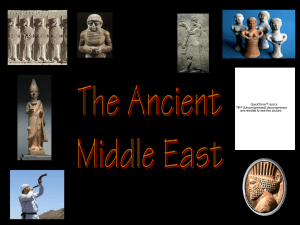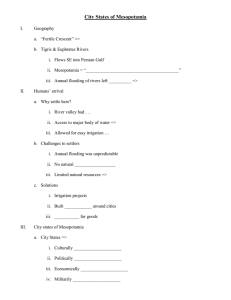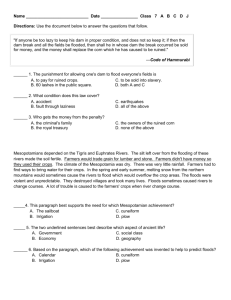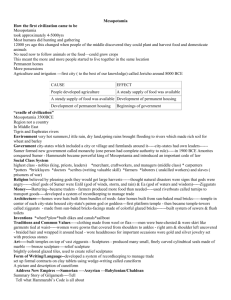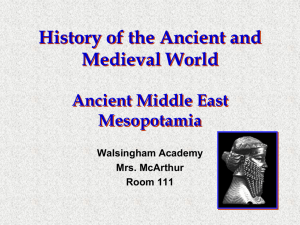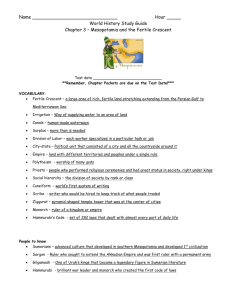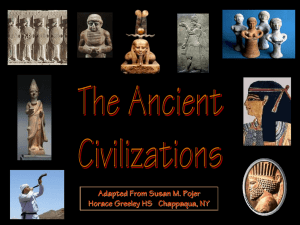RIVER VALLEY CIVILIZATIONS 19
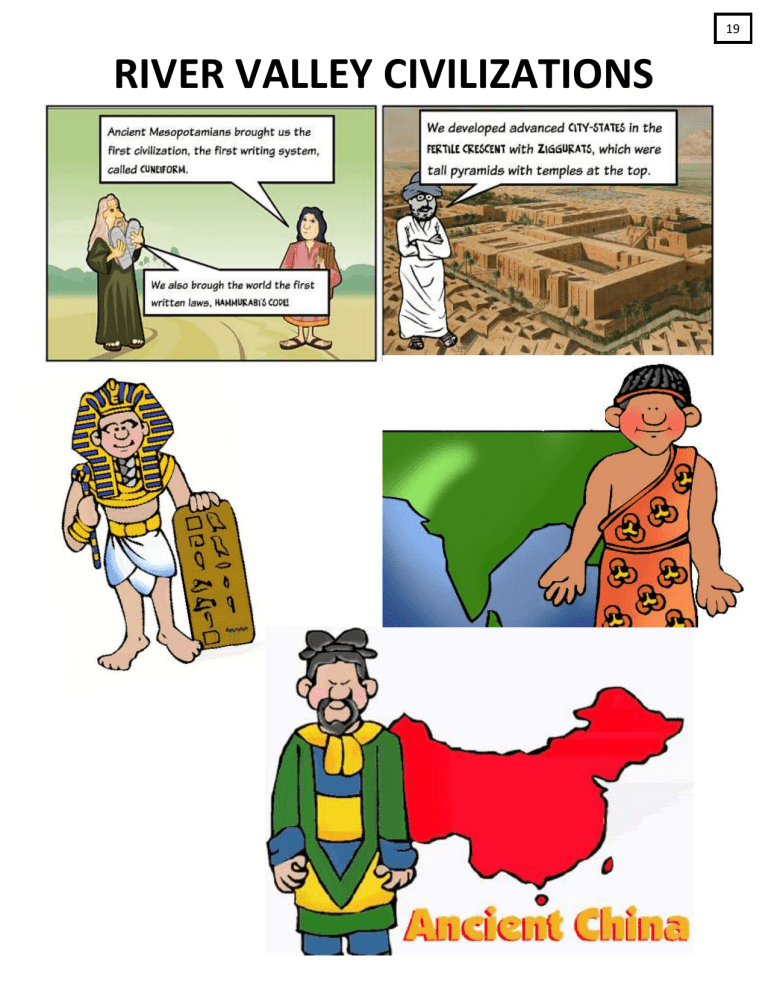
RIVER VALLEY CIVILIZATIONS
19
KEY:
Fertile Crescent
Mesopotamia
Sumer
Egypt
Sahara Desert
Zagros Mountains
20
XXX DO NOT GLUE IN
World History
Egypt and Sumer
- Map
Name: ______________________
Directions: On the back on this handout is a map of the Middle East. Label, draw in, or otherwise identify the items listed below. Use the maps on pages 25, 28, and 34 in your textbook as references. You may find other maps useful as well.
Please make sure to use the directions and/or colors listed next to each item
Bodies of Water (Shade blue and label)
Mediterranean Sea
Red Sea
Persian Gulf
Caspian Sea
Indian Ocean
Rivers (Trace in dark blue and label)
Nile
Tigris
Euphrates
Places
Fertile Crescent – draw a green line around the area
Mesopotamia – shade in the area in light red or pink.
Sumer – shade in the area with purple (will overlap some of Mesopotamia)
Egypt – shade the area of Egypt with orange
Great Pyramids – Use a tan triangle to represent location.
Geographic Features
Zagros Mountains – draw in upside down V’s and color brown.
Sahara Desert – shade yellow
Cities
Label with a name and a dot the location of the following cities:
Memphis, Ur, Babylon, Thebes
Other
Include a key/legend under the map showing what each color represents.
Chapter 2 Section 1
**Read Pages 27-32
Define Fertile Crescent - _____________________________________________________________________
Draw a quick sketch of the Fertile Crescent (see map on page 28) below – be sure to include the rivers:
Describe silt and why it’s important to civilizations –
__________________________________________________________________________________________
__________________________________________________________________________________________
List the 3 environmental challenges of the Fertile Crescent and their solutions:
CHALLENGE
_______________________________
_______________________________
_______________________________
SOLUTIONS
________________________________________
________________________________________
________________________________________
City-State - __________________________________________________________________________
What was at the center of all Sumerian Cities?__________________________________________________
Dynasty - ________________________________________________________________________________
Cultural diffusion - ________________________________________________________________________
Polytheism - ________________________________________________________________
Describe the power of the priests in no less than two sentences:
__________________________________________________________________________________________
__________________________________________________________________________________________
Why did Priests begin to lose some of the power and who emerges as the new leaders of the city-states?
__________________________________________________________________________________________
__________________________________________________________________________________________
21
Sumerian SOCIAL CLASS from highest to low:
_______________________________
_______________________________
_______________________________
_______________________________
22
Sumerian science and technology included what 15 items:
__________________________ __________________________
__________________________
__________________________
__________________________
__________________________
__________________________
__________________________
__________________________
__________________________
__________________________
__________________________
__________________________
__________________________
__________________________
Who was Sargon of Akkad, what did he take control of, and what did the create?
__________________________________________________________________________________________
__________________________________________________________________________________________
Empire: ____________________________________________________________________________
What happen to the Dynasty of Sargon?
__________________________________________________________________________________________
__________________________________________________________________________________________
What year was the Babylonian empire created? _____________________________
Who was Hammurabi and what is his legacy?
__________________________________________________________________________________________
__________________________________________________________________________________________
Explain the importance/significance on the code of laws?
__________________________________________________________________________________________
__________________________________________________________________________________________
__________________________________________________________________________________________
__________________________________________________________________________________________
What three groups would later adopt many of the Sumerian ideas?
________________________ ________________________ _______________________
What other civilization was experiencing a rise a fall similar to Mesopotamia around the same?
____________________________________
23
24
Ziggurat
The symbolism of the mountain in world mythology was of such crucial importance to the concept of cosmic order that the ancient Mesopotamians tried to replicate the mountain by building pyramidal mud brick towers called ziggurats. Those towers were constructed in most major cities between 2200 and 550 B.C. and most likely served as the observatories from which the Babylonians calculated the movements of the celestial bodies and developed astronomical methods unrivaled even by scientists of the Victorian Age. To a large extent, the vision of the earth and the sky determined early perceptions of the universe. The Mesopotamians felt the need to build ziggurats high enough to afford them a panoramic view of the world, and the Maya tried to achieve something similar with their pyramids and temple towers. Those early people replicated the world mountain and thus, they believed, simulated the power of the peaks.
25
The ziggurats of the ancient world also served a purpose that was loftier than mortal sky watching. Like the world mountain itself, ziggurats provided paths for mortals to reach the sky realm and for gods to descend to earth. Sumerian sky watchers saw the universe as a mountain that rose from the sea and extended into the sky, so the ziggurats they built had their base in the underworld and steep external stairways climbing toward
Heaven and to the temples of the gods, built on the summits. The most famous ziggurat was the Tower of
Babel, which accommodated on its summit a temple to Marduk to honor him for his role in creation. Other ziggurats had temples to other gods, including the structures at Nippur, with its temple to Enlil, the god of air, and the best-preserved example of a ziggurat at Ur, with its temple to Nanna, the moon god.
1.
Why did ancient Mesopotamians build ziggurats?
2.
Why did they build the ziggurats so high and who also shared this concept in their temple building?
3.
What spiritual purpose did ziggurats serve for the people and their gods?
4.
What was the most famous ziggurat and who was honored on top?
5.
Three gods are mentioned in the reading. Who are they and what do they represent?
Cuneiform
One of the world's oldest known writing systems, cuneiform made it possible for the ancient cultures of Mesopotamia to keep track of their expanding empires via a literate bureaucracy. The invention of a symbolic writing system also allowed the people of the region to record their spiritual, social, and political values, as well as literature and history.
Created by the Sumerians during the fourth millennium B.C., cuneiform writing was a revolutionary invention that changed human history dramatically. The term "cuneiform" is a Latin title that means "wedge shaped," referring to the manner in which cuneiform was created. Sumerian scribes began to write their earliest versions of cuneiform as pictographs, similar to Egyptian or
Mesoamerican hieroglyphs in concept.
There were many reasons why cuneiform was necessary, but one of the most important was the need for keeping track of such financial records as tax records and trade and commerce receipts. The earliest cuneiform texts merely count quantities in fragment sentences. By the time cuneiform had developed into a syllabic character set, scribes wrote complete sentences that expressed mental concepts as well as numeric quantities. Thus, cuneiform shifted from a bookkeeping method to a full-fledged literary system capable of recording the laws, literature, and personal writings of entire societies.
Some of the most important documents in ancient history were written in cuneiform, and their significance reflects the impact literacy has on societies in general. Written histories, laws, and religious texts work to fix cultural values and standards in ways that oral traditions do not. Mesopotamian governments benefited greatly from cuneiform by publishing their laws in the language. By presenting the public with written law codes, leaders were able to expect their citizens to actually abide by the rules; citizens could not claim ignorance of the laws. As a result, laws were codified using cuneiform throughout the region.
Cuneiform also made it possible for Mesopotamian cultures to record their myths, legends, and religious values. Theologians wrote histories and genealogies of the gods, compendiums for reading omens, and guidebooks for temple worship. Epic poems were also created, detailing the lives of the gods and events of supernatural phenomena. One of the most important literary works is the Epic
of Gilgamesh, a Babylonian tale that tells of a heroic figure who sets out to face the gods. Those texts served not only to educate and entertain, but to disseminate religious faith. Because of the fixed nature of texts, they also worked to solidify beliefs that may have been more malleable had they only passed through oral traditions.
Finally, one of the most important innovations of cuneiform writing was that it allowed individuals to write letters and other egodocuments that historians can use for a glimpse into their inner lives. There are hundreds of thousands of such documents that have been discovered so far. Taken together with the bureaucratic, legal, and religious texts of the Mesopotamians, they give historians a deeper understanding of the readers and writers of cuneiform, far more complete than many other ancient societies that existed without literary documents.
1.
What is cuneiform and what does it mean?
2.
What was the benefit of publishing laws in the language of their people?
3.
Besides laws, tax records and receipts, what else did cuneiform make possible to record?
4. How have historians been able to get a glimpse into the inner lives of the Sumerian people?
26

